

Carnyx. Design — Stalled! Untitled. Phantom Islands — A Sonic Atlas. Plastic-eating worms may offer solution to mounting waste, Stanford researchers discover. September 29, 2015 An ongoing study by Stanford engineers, in collaboration with researchers in China, shows that common mealworms can safely biodegrade various types of plastic.

By Rob Jordan Mealworms munch on Styrofoam, a hopeful sign that solutions to plastics pollution exist. Wei-Min Wu, a senior research engineer in the Department of Civil and Environmental Engineering, discovered the larvae can live on polystyrene. (Photo: Yu Yang) Consider the plastic foam cup. Enter the mighty mealworm. "Our findings have opened a new door to solve the global plastic pollution problem," Wu said. The papers, published in Environmental Science and Technology, are the first to provide detailed evidence of bacterial degradation of plastic in an animal's gut. Adam Savage's One Day Builds: Totoro Costume! Mealworm Anatomy. The mealworm is a worm-like larva with a hard exoskeleton.
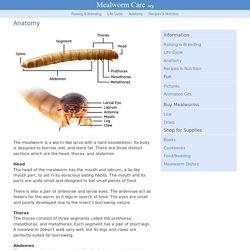
Its body is designed to burrow, eat, and store fat. There are three distinct sections which are the head, thorax, and abdomen. Head The head of the mealworm has the mouth and labrum, a lip-like mouth part, to aid in its voracious eating habits. The mouth and its parts are quite small and designed to eat small pieces of food. MECHANICAL TECHNO DEMONSTRATION. 10 Amazing Examples of Mind Over Matter. Humans While we often think of our bodies and minds as two distinct entities, it turns out they are much more entwined than we might assume.

Researchers are continually finding evidence that the brain has a distinct power to manipulate the body’s physiology. As these 10 examples show, the mind/body connection can work in our favor or detriment, depending on our knowledge of a situation and our ability to control our thoughts. Judging by their ability to meditate for hours on end, to abstain from food for days, and their vows of silence, most us would agree that Tibetan Monks have better control over their minds and bodies than the average person. Still, what’s particularly amazing is some of them can control physiological processes, such as blood pressure and body temperature – feats many medical doctors find astounding. The Bloodbath of B-R5RB, Gaming’s Most Destructive Battle Ever.
In the universe of EVE Online, players from every timezone around the globe have been waging wars on a massive scale for nearly 11 years. Some conflicts have been relatively small grudge matches between rivals from adjoining solar systems with maybe a dozen or so frigates and cruisers facing off in fast-paced combat. Others, like the Great War, are fueled by tens of thousands of players and blossom with all the same propaganda, diplomacy (and espionage), supply-chain logistics and military tactics that might fuel a real-world conflict, taking months to resolve and changing entire industrial patterns across the star map.
100 Years of Breed “Improvement” For the sake of honest disclosure, I will admit to owning “purebreds” (the ‘pureness’ of purebreeds is a discussion for another time) but I also have mutts.
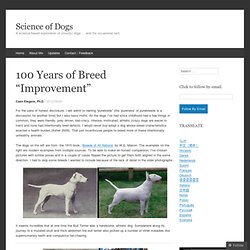
All the dogs I’ve had since childhood had a few things in common, they were friendly, prey driven, ball-crazy, intense, motivated, athletic (crazy dogs are easier to train) and none had intentionally bred defects. I would never buy/adopt a dog whose breed characteristics exacted a health burden. (Asher 2009). Mirrors finally bring winter sun to Rjukan in Norway. 30 October 2013Last updated at 14:00 ET Rjukan gets no sunlight for about seven months of the year because it is in a valley surrounded by mountains, as Verity Wilde reports The people of Rjukan in Norway are celebrating the installation of giant mirrors, which have finally brought winter sunshine to their town centre.
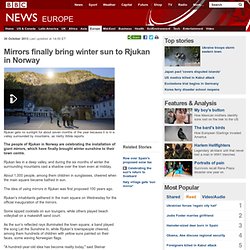
Rjukan lies in a deep valley, and during the six months of winter the surrounding mountains cast a shadow over the town even at midday. About 1,000 people, among them children in sunglasses, cheered when the main square became bathed in sun. The idea of using mirrors in Rjukan was first proposed 100 years ago. How to Draw a Human Heart by Emon Hassan Narratively. Stappenplan - Beroepkunstenaar - Beeldende kunst. To Flavour Our Tears – A restaurant where insects can feast on us – We Make Money Not Art. Image Center for Genomic Gastronomy A few years ago, entomologist discovered that some moths and bees suck the tears from underneath the eyelids of birds and mammals (including humans) while they sleep.

Institute of Critical Zoologists. "The work to follow is an exploration of these complexities and reminds us that birds occupy a large and central part of that universe that human beings constantly carve out of nature.
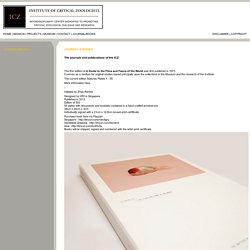
" Ding Li “In contemporary society birds are, perhaps, both the most watched and most eaten animal on our planet. They have become a focal point of debates about a 'proper' relationship between humankind and nature, and about definitions of humanity itself.” Thomassons: Those Peculiar Architectural Relics That Serve No Purpose. Brooklyn Heights, Brooklyn, NY, United States We’ve all seen them.
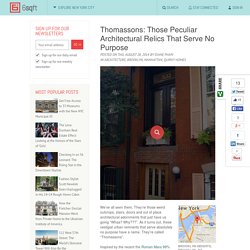
They’re those weird outcrops, stairs, doors and out of place architectural adornments that just have us going “Whaa? Why???”. As it turns out, these vestigial urban remnants that serve absolutely no purpose have a name. Conservation and restoration of plastic objects. Conservation and restoration of objects made from plastics is an activity dedicated to the preservation and protection of objects of historical and personal value made from plastics.
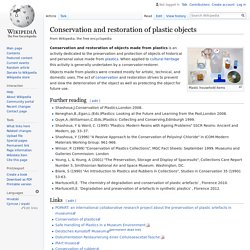
When applied to cultural heritage this activity is generally undertaken by a conservator-restorer. Further reading[edit] Yakhchal: Ancient Refrigerators - Earth Architecture. Yakhchal in Yazd Province By 400 BC, Persian engineers had mastered the technique of storing ice in the middle of summer in the desert. The ice was brought in during the winters from nearby mountains in bulk amounts, and stored in a Yakhchal, or ice-pit. These ancient refrigerators were used primarily to store ice for use in the summer, as well as for food storage, in the hot, dry desert climate of Iran.
Dans L'atelier version 3min30. In Residence Ep 14: “Ricardo Bofill” by Albert Moya - NOWNESS presents. The Tsubo-en Zen garden; Nightingale floor, Uguisubari (鴬張り) We have had the distinct pleasure of walking over the nightingale floor at Nijo Castle and in Toji-in temple both in Kyoto.

Plastiglomerate - Journal #78 December 2016. The conditions that obtained when life had not yet emerged from the oceans have not subsequently changed a great deal for the cells of the human body, bathed by the primordial wave which continues to flow in the arteries. Our blood in fact has a chemical composition analogous to that of the sea of our origins, from which the first living cells and the first multicellular beings derived the oxygen and the other elements necessary to life … The sea where living creatures were at one time immersed is now enclosed within their bodies. —Italo Calvino, Blood, Sea. Your Personal Bubble Isn't Empty Space, It's Actually Teeming with Tiny Guests. You are never alone: With every step you take, a bubble of particles follows. Microbes, chemicals, fungi, microscopic animals and other little biological crumbs constantly move around us and form what's called an "exposome" — or everything we're exposed to in the moment.
"Human health is influenced by two things: your DNA and the environment," senior author Michael Snyder, professor and chair of genetics at Stanford University, said in a statement. "People have measured things like air pollution on a broad scale, but no one has really measured biological and chemical exposures at a personal level. " [Body Bugs: 5 Surprising Facts About Your Microbiome] "No one really knows how vast the human exposome is or what kinds of things are in there," he added. The researchers recruited 15 participants to wear a small device strapped to their arm wherever they went. Top Creepiest Animal SOUNDS Ever. Midtown Exchange. The Midtown Exchange is a large commercial building located in the Midtown Phillips neighborhood, in Minneapolis, Minnesota, United States.
It is the second-largest building in Minnesota in terms of leasable space, after the Mall of America. It was built in 1928 as a retail and mail-order catalog facility for Sears, which occupied it until 1994. It lay vacant until 2005, when it was transformed into multipurpose commercial space. The building is listed on the National Register of Historic Places as the Sears, Roebuck and Company Mail-Order Warehouse and Retail Store. Begich Towers. Coordinates: Macghillie _ just a void.
New Artwork: Pixelhead - Martin Backes - Official WebsiteMartin Backes – Official Website. Designer's Notebook: The Role of Architecture in Videogames. Halletmek. The Turkish art of speeding up design processes. Planten – Preserved Nature. Luchtwachttoren Schoonebeek. Wieringen. Kauai O'o, Hawaiian Forest Bird. French theme park deploys birds to collect litter. Image copyright Getty Images. Bodily Matters: Human Biomatter in Art (part 4. On skin and hair) – We Make Money Not Art. Interview with Cecilia Jonsson, the artist who extracts iron from invasive weeds. Mischer'traxler the idea of a tree. Namibian village gets meat from hunted black rhino - CNN. Black rhino hunt: Why killing one bull is worth it for conservation - CNN. Vtol. Iñaki Aliste Lizarralde. Energy harvesting.
Tim Knowles - Balloon Drawings - Civita 24hr Balloon Drawing. Trophy hunting. Texas hunter bags rhino on controversial Namibia hunt - CNN. Comfort object - Wikipedia. The body as an artistic medium. Inquisitive Devices. 'Treincoupé' met videolandschap voor dementen in rusthuis. .: Neighbourhood Satellites :. Hogeweyk. Vaughn Bell - Projects. Albedo Dreams. Experiments in DIY climate manipulation – We Make Money Not Art. DIY climate manipulation. Neo-Nature (or why we should “Let the Pandas Die”) – We Make Money Not Art. Meatwreck. Battle of Concepts. Garden hermit needed. Apply within. The butterfly mobile lab of Stefan Cools – We Make Money Not Art. The Woodpecker: Could fake birds save our forests? – We Make Money Not Art. Things You Never Knew You Needed: An Ornamental Hermit. Perpetual stew. Top 10 Bizarre Dioramas.
Cargo cult. Places of Horror - The Secrets of Scary Settings - Extra Credits. Workshops/CoreMemoryMarathon - OpenSource Wiki. Studer/van den Berg: Passage Park #2: The Container. Burglars Beware - Police Capture House. Persona. Or how objects become human – We Make Money Not Art. Retrotechtacular: Examining Music in 1950’s Russia. HISTORY OF IDEAS - Manners. A guide to life forms altered by the human species – We Make Money Not Art. HISTORY: CONSUMERISM.